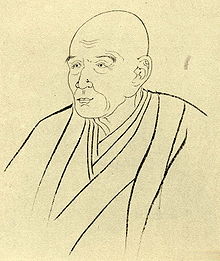Kyokutei Bakin
Kyokutei Bakin ( Japanese 曲 亭 馬 琴 ; * July 4, 1767 ( traditionally : Meiwa 4/6/9) in Edo (now Tokyo ); † December 1, 1848 (traditionally: Kaei 1/11/6)) was a Japanese writer .
Names
Kyokutei Bakin is a two-part stage name that is a complex play on words. Kyokutei comes from the Chinese historical work Han Shu , Bakin from the Setsuwa collection Jikkinshō . However, the characters can also be read as kuruwa de makoto (actually: 廓 で 誠 ), which means something like "[a man who] sincerely [dedicates himself] to the [prostitute in the] brothel district". His childhood name was Kurazō ( 倉 蔵 ), his real name was Takizawa Okikuni ( 滝 沢 興邦 ), where he later changed his first name to Tokuru ( 解 ) as a commoner . He is also known in the combination of his family and stage name Takizawa Bakin ( 滝 沢 馬 琴 ). Other artist names were u. a. Chosaku Dōshujin ( 著作 堂主 人 ), Saritsu Gyoin ( 蓑笠 漁 隠 ) and Gendō ( 玄同 ).
Life
The fifth son of the samurai Takizawa Okiyoshi ( 滝 沢 興義 ) in the service of Prince Matsudaira Nobunari had to earn his living after the untimely death of his father and his older brothers. After working in subordinate samurai posts and training as a doctor, he finally turned to writing.
In 1790 he sought out the author Santō Kyōden to become his student. Santō Kyōden rejected the request, but brokered Bakin the following year the publication of his first Kibyōshi Tsukai hatashite nibu kyōgen ( 盡 用 而 二 分 狂言 ). By 1805, Bakin published a total of 79 Kibyōshi, the most important of which is Myō-kinako kogome Dōmyōji ( 妙 黄粉 毇 道明寺 , "Strange bean flour and broken rice from Dōmyōji Temple").
In 1792 he took the stage name Kyokutei Bakin . In the following year he married into a middle class family and gave up his samurai status. He gave up the family's Geta shop and earned his living as a calligraphy teacher, but with increasing success as a writer.
After a trip along the Tōkaidō , his Yomihon Geppyō kien ( 月 氷 奇 縁 , "Strange coincidences under the ice moon") appeared in 1803 . Bakin subsequently wrote other works in this genre, including Chinsetsu yumiharizuki ( 椿 説 弓 張 月 ) and, between 1814 and 1842, the successful historical novel series in 106 volumes Nansō Satomi Hakkenden ( 南 総 里 見 八 犬 伝 , “The story of the eight dogs from Satomi in Nansō ”). In 1839, while he was still writing, he lost his sight.
Web links
Individual evidence
- ↑ a b c 杉 本 苑 子 : 滝 沢 馬 琴 . In: 朝日 日本 歴 史 人物 事 典 at kotobank.jp. Asahi Shimbun Shuppan, accessed December 26, 2011 (Japanese).
- ↑ a b c d e f g Stella Bartels-Wu: Mitatemono and kibyôshi . Edition, adaptation and translation "Myô-kinako kogome Dômyôji" (1805) by Takizawa Bakin. Harrassowitz, 1994, ISBN 3-447-03369-X , p. 13–16 ( limited preview in Google Book search).
- ↑ 滝 沢 馬 琴 (た き ざ わ ば き ん) (Takizawa Bakin) . In: 京都 通 百科 事 典 . Retrieved December 27, 2011 (Japanese).
- ↑ 滝 沢 馬 琴 . In: 美術 人名 辞典 at kotobank.jp. Shibunkaku, accessed December 26, 2011 (Japanese).
- ↑ a b c Haruo Shirane: Early Modern Japanese Literature: An Anthology, 1600-1900 . Columbia University Press, 2008, ISBN 978-0-231-14415-5 , pp. 484 ff . ( limited preview in Google Book search).
| personal data | |
|---|---|
| SURNAME | Kyokutei, Bakin |
| ALTERNATIVE NAMES | 曲 亭 馬 琴 (Japanese); Takizawa Okikuni (real name); 滝 沢 興邦 (Japanese, real name); Takizawa Bakin (alternative name); 滝 沢 馬 琴 (Japanese, alternative name) |
| BRIEF DESCRIPTION | Japanese writer |
| DATE OF BIRTH | 4th July 1767 |
| PLACE OF BIRTH | Edo (now Tokyo ) |
| DATE OF DEATH | December 1, 1848 |

